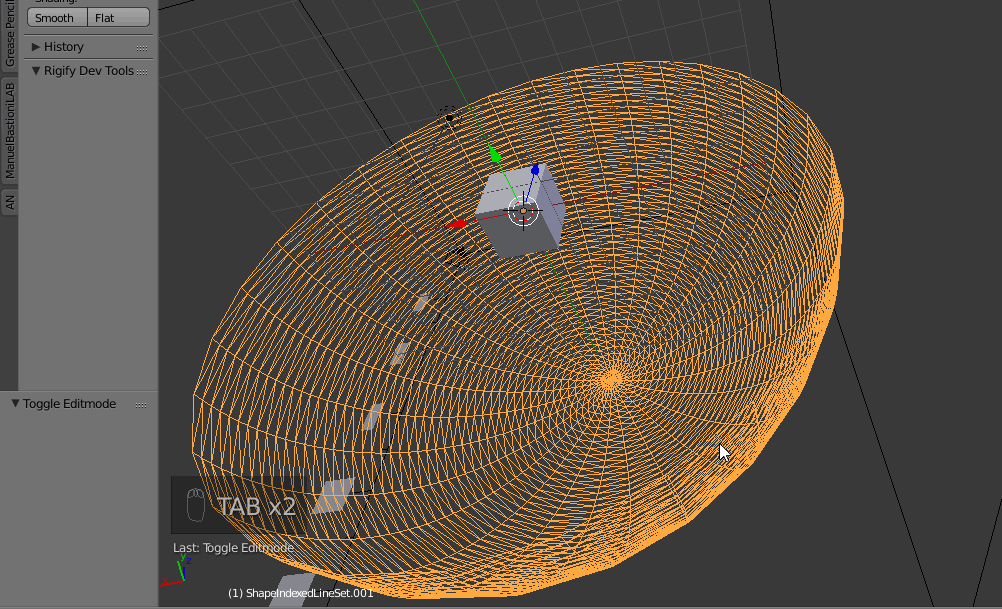У меня есть программа, которая создает облако точек вместе с информацией о ребрах, то есть связь между точками.Я хотел бы иметь возможность создавать лица из этих данных.В настоящее время я использую простой алгоритм, который выглядит следующим образом:
int CMesher::Poligonize(){
unsigned int i0 = 0;
unsigned int i1 = 0;
int num = this->_nodenum;
int facenum = 0;
for (i0 = 0; i0 < num; i0++)
for (i1 = 0; i1 < num; i1++){
if (i1 <= i0)
continue;
if (this->IsEdge(i0, i1))
facenum += this->PoligonizeEdge(i0, i1);
}
return facenum;
}
int CMesher::PoligonizeEdge(unsigned int i0, unsigned int i1){
int facenum = 0;
unsigned int* Ci01 = <unsigned int*>d_malloc(
sizeof(unsigned int)*this->_nodenum);
int Ci01_num = 0;
//get the list of common neighbours between i0 and i1,
//Ci01=n0,...,ni,.., nK
this->GetShared(i0, i1, Ci01, this->_nodenum, &Ci01_num);
unsigned int ni = 0;
unsigned int n0, n1;
int it0 = 0;
//For each common neighbour ni in Ci01
while (it0 < Ci01_num){
ni = Ci01[it0];
//create a face f {ni, i0, i1}
facenum += this->CreateFace(ni, i0, i1);
it0++;
//If i0 and i1 have NO common neighbours
unsigned int* NB0 = <unsigned int*>d_malloc(
sizeof(unsigned int)*this->_nodenum)
int NB0_num = 0;
int NB0_mem = this->_nodenum;
unsigned int* NB1 = <unsigned int*>d_malloc(
sizeof(unsigned int)*this->_nodenum);
int NB1_num = 0;
int NB1_mem = this->_nodenum;
unsigned int it1 = 0;
unsigned int it2 = 0;
unsigned int* Cn01 = <unsigned int*>d_malloc(
sizeof(unsigned int)*this->_nodenum);
int Cn01_num = 0;
int Cn01_mem = this->_nodenum;
unsigned int n2 = 0;
if (Ci01_num == 0){
//Get the lists of neighbours of i0, NB0, and of i1, NB1
this->GetNeighbours(i0, NB0, NB0_mem, &NB0_num);
this->GetNeighbours(i1, NB1, NB1_mem, &NB1_num);
//For each neighbour n0 in NB0, and n1 in NB1
it0 = 0;
while (it0 < NB0_num){
n0 = NB0[it0];
if (n0 == i1){
//i0 is al. a neighbour of i1, and vice versa
it0 += 1;
continue;
}
it1 = 0
while (it1 < NB1_num){
n1 = NB1[it1];
if (n1 == i0){
//i0 is al. a neighbour of i1, and vice versa
it1 += 1;
continue;
}
isE = this->IsEdge(n0, n1);
//if n0 and n1 are connected
if (isE > 0){
//Create two faces {i0, i1, n0} and {i1, n0, n1}
facenum += this->CreateFace(i0, i1, n0);
facenum += this->CreateFace(i1, n0, n1);
}else{
//get the list of common neighbours between n0 and n1, Cn01
this->GetShared(n0, n1, Cn01, Cn01_mem, &Cn01_num);
it2 = 0;
//for each n2 in Cn01
while (it2 < Cn01_num){
n2 = Cn01[it2];
//Create 3 faces {i0, i1, n2},
//{i1, n1, n2}, {i1, n0, n2}
if (n2 == i0 or n2 == i1){
//n2 cannot be n0 or n1, only i0 or i1
it2 += 1;
continue;
}
facenum += this->CreateFace(i0, i1, n2);
facenum += this->CreateFace(i1, n1, n2);
facenum += this->CreateFace(i1, n0, n2);
it2 += 1;
}
}
it1 += 1;
}
it0 += 1;
}
}
//delete the lists
free(Ci01);
free(Cn01;
free(NB0);
free(NB1);
return facenum;
}
//Not described here, but obvious
int CMesher::IsEdge(unsigned int n1, unsigned int n2);
int CMesher::DeleteEdge(unsigned int n1, unsigned int n2);
int CMesher::CreateFace(unsigned int n1, unsigned int n2
unsigned int n3);
//Return a vector of nodes(vertice)
// linked to both n1 and n2
//@param shared: the input vector containing the vertice
//@param sharedmem: the size in memory of the input array
//@param sharednum: the actual number of shared vertice //found
int CMesher::GetShared(unsigned int n1, unsigned int n2,
unsigned int* shared, int sharedmem, int* sharednum);
//Returns a vector of nodes(vertice)
// linked to both n1
//@param neighbours: the input vector containing the //vertice
//@param neighmem: the size in memory of the input array
//@param neighnum: the actual number of neighbours vertice //found
int CMesher::GetNeighbours(unsigned int n1,
unsigned int* neighbours, int neighmem, int* neighnum);
Я пробовал код выше, но у меня нет хорошей триангуляции.Слишком много совпадений.Другими словами, конечная сетка не является многообразием.
Вопрос : Есть ли лучший алгоритм?Или как я могу улучшить свой алгоритм?Кстати, я не использую Marching cubes или Delaunay triangulation, так как 90% работы уже сделано, т.е. у меня есть топография (взаимосвязь между точками).MC и Delaunay работают только с облаками точек без топографии.ADEMDUM 1: Blender 3D делает именно то, что я пытаюсь сделать программно.Вот захват шляпы: 